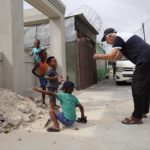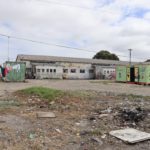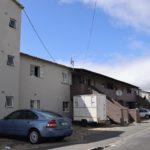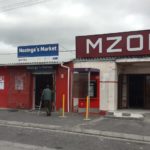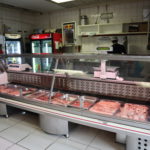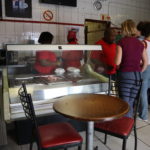Before my visit, I had thought about visiting a Township, but felt discouraged by the reports about violence there. Thus, I was positively surprised to see that City Sightseeing offered Township tours as well. We booked one, and my first question to the guides was how the people in the Township would feel about us visiting them because I did not want to have a weird zoo-experience. They explained to us that they understood the importance of tourism as it showed that it was reasonably safe – which potentially attracted investors – plus pointing out the deficits put pressure on the government as they were “failing the people” for years.
We took off in a minibus to Cape Town’s oldest Township Langa, where our two guides from the Xhosa tribe grew up. About 200’000 people were registered there, about the size of Basel. They dropped us off at the registration office where the black people called in from the countryside had to report during the Apartheid to receive their “Dumb Pass”. They were considered stupid by the whites because many did not speak English or Afrikaans. The fact that they spoke multiple local languages was conveniently overlooked. Upon registration, they went to the “Court” where the classification regarding their potential usage took only one minute. Men were squeezed in large numbers in a small room in that office building while women were hurdled in an outside pen. Families were often separated upon arrival.
After this touching introduction, we started walking. Many people didn’t seem to care that we were there and showed a neutral attitude towards us. The kids seemed happy and curious. The younger ones had fun posing for our cameras, and some older ones showed traditional singing to a different group of visitors for a little tip. A group of girls in school uniforms passed us. The atmosphere was calm. We walked past WIFI stations, donated by the Gates Foundation to enable people to apply online and be part of the online world.
We learned that people from the countryside or other countries came to Cape Town looking for work, only to find out that there wasn’t much. After registration, they received accommodation. In reality, the whole family either shared a family room (2x2m) or one half of a 20′ container: no running water, no electricity. Washing facilities were available in a separate building. When I ducked under washing lines of fresh laundry past the women and kids there, the dreaded feeling of awkwardness crept up on me, so I quickly stepped through and back to the square. Here I saw tired-looking buildings, living containers, grass with pieces of garbage, the remainders of a little bonfire. In the far end, there was a brightly coloured shed with motivational phrases painted upon it. I asked about the availability and affordability of contraceptives. I learned that they’re available, but families often decided to have more children to receive the financial allocation from the state for each child as this sometimes was their only income that put food on the table.
Our next stop was a souvenir booth. The guide highlighted this particular one because the owner taught the local kids how to craft so that they learn how to earn some money. They sold lots of pretty things, but to avoid clutter at home I just bought what I always do: a magnet. I didn’t mind the price of 150 ZAR / 8 EUR as it was a small thing to contribute to the Township.
Our minibus picked us up, and we drove through the other parts of the Township. The unofficial settling looked like how I honestly imagined the Township to be like: shacks made of corrugated metal, piles of garbage and people were not as happy to see us. The guides did their best to ensure that this was probably just because we were in a vehicle and not engaging with them, but honestly, I couldn’t blame them. These rich tourists were driving past their front door like through a zoo. I wouldn’t have appreciated that either.
There were two more areas we drove through while we learned about the different “classes” within a Township. The lower class were the people living in the illegal settlement and containers and family rooms with barely met basic needs. The middle class had received housing from the government: a two-bedroom open-plan flat – again for the whole family. In front of these row houses parked some cars and you might meet quite a few familiar Uber drivers faces there. The upper class of those who “made it” had well-kept family homes with little yards, framed by fences but without any bars in the windows. We learned that when people moved up the ladder of success, they didn’t leave the Township. They instead moved to another area within it so that they could keep their social contacts and continue pursuing their cultural customs. Beheading chicken and other rural traditions were frowned upon in other areas of Cape Town.
Just in time for lunchtime, we made a halt at a butcher, who offered traditional hot meals for the locals. After some initial hesitation, each in our little group bought some portions for a few Euros. Allegedly Jamie Oliver had eaten there before us. My approach was: if this is good enough for Jamie Oliver, it’s undoubtedly good enough for me.
While eating our lunch in the minibus, our guides drove us to another Township called Gugulethu, which had about 400’000 inhabitants. Here we stopped at two monuments: one was for seven young men who were betrayed by their 8th friend and shot dead for their activism against Apartheid. The other one was for Amy Biehl, a young American activist against Apartheid who was killed by four men “to make a point”. They were caught and went to prison. After their sentence, two of them went to Amy’s mother, asking for forgiveness. Who could forgive the murder of his own child? Amy’s mother could and did. They even worked together in the Amy Biehl Foundation and fought for the right of health, education, and employment in South Africa.
We were still quite affected when we arrived back at the starting point, and I felt a bit out of place amongst all the tourists. It felt good to have someone to talk about what we just had seen and experienced. I think if you visit a place like Cape Town you have to visit the not-so-nice parts of the city as well as the beautiful sites. How else can you see the whole picture and get a complete impression of the city?







